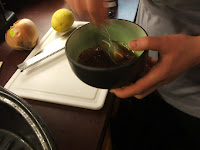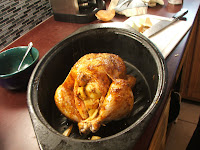My morning began with an interview with the extraordinarily gifted Susi Gott Seguret, the force of nature that directs the Swannanoa School of Culinary Arts (SSCA) over on the grounds of Warren Wilson College. Susi spends much of her time in France (we spoke via web cam), but makes magic when she returns to Asheville. The SSCA is a yearly event that features all sorts of kitchen workshops headed by incredible (mostly local) talent. She spoke about the recent truffle festival in this area, and that led to a conversation about the culinary gold to be found in these parts. Though most of our markets don't exactly offer the selection of bizarre animal organs that can be procured in her neck of the woods, we do have access to an astounding array of humanely raised meats and heirloom veggies -- something to be proud of. Susi is bringing molecular gastronomy pioneer and mad chemist Herve This to Asheville to kick off this year's SSCA with some really intriguing demonstrations. Check it:
Already moving beyond the tremendous wave of inspiration he sparked with
Molecular Cuisine, his current innovations are with a new science called “Note by Note Cooking”, where each specific flavor in each dish represents a note which, coupled with other flavors, compose a musical piece and, together with a sequence of dishes, make up a symphony for the palate.
I can't tell you that I understand exactly what the heck that means, but it sounds fascinating. Susi says that all of the classes are very immersive and open to all skill levels. I highly recommend checking them out if you are in the Asheville area (or can manage to be this summer) -- and yes, registration is still open. http://www.schoolofculinaryarts.org/ Look for my interview with Susi in the next issue of Verve. http://www.vervemag.com/
I also spent the past few days kicking it around Green Hill Urban Farm interviewing a farmer, Mike Fortune, who has his hands very full with several acres of land where he farms bio-dynamically and organically right on the edge of urban(ish) West Asheville. Mike, at age 30, is part of a wave of young farmers in this area that are highly dedicated to the stewardship of the land that has fallen to them. We will be featuring Green Hill on the cover of the Mountain Xpress http://www.mountainx.com/ on July 17th, and it should be worth the read. Green Hill is just another one of those places in Asheville that feels like a bustling hive of creativity, and despite its serving a large number of CSAs, feels more like a thriving community center than a business. I'll likely post a podcast of the interviews from my session on the farm -- they will make an entertaining listen. Learn more about Green Hill here: http://greenhillurbanfarm.com/page.cfm?pg=113
Today I also had the fortune to visit with Sally Eason of Sunburst Trout Farms, the burbling trout streams of which are fed by waters that flow downstream from the pristine Pisgah wilderness. She was a pleasure to talk to, and the interview I had with her will form a great story for the upcoming food-centric issue of Verve. The farm itself is absolutely stunning -- the kind of place where butterflies are flitting around a backdrop of a million shades of green. Today there was even a double rainbow. It was almost stupidly beautiful. The trout that are netted in the streams on the property are gargantuan as far as trout go, and they are gorgeous in color due to a specially developed, patented all-natural hormone and animal byproduct-free feed that the fish are given. While many fisheries add all kinds of nasty things to the feed to give the flesh of their fish color, Sunburst gives their fish the same antioxidant found in blueberries to make them look like this:







































